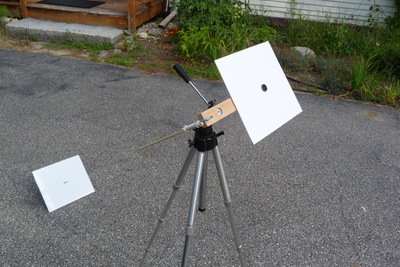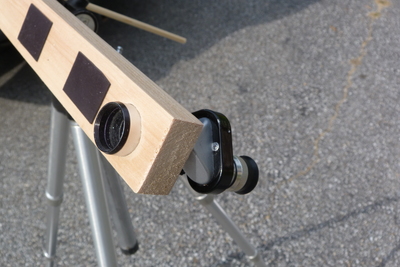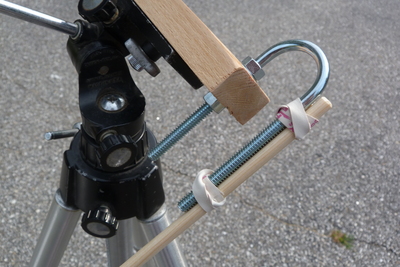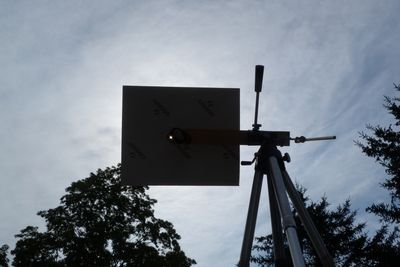Ric's Eclipses
This started out as a web page about solar projection. I wrote it before seeing a total
solar eclipse, and I named it index.html. It's really not an index page, but since solar
projection is a great tool for any solar eclipse, I'll keep it here and simply mention
eclipses I have seen and link to pages that have a lot to say.
There are three major classes of solar eclipses
- Partial solar eclipse
Part of the sun gets covered by the moon. Sometimes you don't even notice that it's
happening. They're interesting for a few minutes and worth checking near the maximum, but
that's about it unless you're climbing in a silver maple tree where you see thousands of pinhole
camera images of the sun with a chunk taken out of it. Small images, big images, sharp images,
fuzzy images, all with a brightness that is a function of size and sharpness.
- Annular eclipse
If the moon is far away, near apogee, it's too small to cover the sun. Conversely, if the
Earth is too close to the sun, near perihelion in January, the sun is too large for the moon to
cover it. The best you can do is to get a ring around the moon and see some weird lighting
effects. They're worth driving 100 miles or so to see, but that's about it.
- Total eclipse
This is the Big Kahuna, an event so huge that you cannot take it all in. Many people see
one of these and spend the rest of their vacations traveling to see all the rest, sometimes to
really out of the way places. I can sympathize with them, but I'm relieved to say I will not be
joining them.
"My" eclipses
I've now seen one annular eclipse and two total eclipses. Here are four links to them:
[1994] New England annular
eclipse
This was the first solar eclipse I saw that had a "third" and "fourth" contact. I had
taken note of previous partial eclipses, but this was the first time I saw the weird
lighting and shadow effects that arise deep into the partial phase. I watched the entry
into annularity in a telescope, it was neat seeing the two tips of the closing crescent
approach and touch in real time. It was analogous to seeing a hand of a 29 day clock
move. Back in my childhood days I could see a hour hand move on my grandparent's mantel
clock, and that's some 58 times faster.
I let a friend see third contact at the end of annuality. All in all, worthwhile, but no
corona....
[2017] Great American Eclipse: The Werme Expedition
If "they" say "You never forget your first total solar eclipse," I fully agree. This was
a family affair starting in Bend Oregon. Bend was outside of totality, but it's pretty
easy to get to the mountains without fighting traffic, just wildfire smoke. I thought the
annular eclipse meant I was well prepared, but no, nothing can adequately prepare you for
the entry into totality. The best you can do is record people reacting to it.
[2024] Great North American Eclipse: Ric's Solo Trip
This eclipse went from Mexico to Canada, hence the obvious name for it. The April timing
brought risks of springtime clouds in places I've lived before, so I decided to stay
nearby and take my chances. I got lucky - northern New England had good viewing, though
where I was a thin cirrus overcast had an impact similar to wildfire smoke.
[2017, 2024] Vihart wasn't ready for
this
I grew up during the Golden Era of Scientific American. My favorite section, as it was
for many, was Martin Gardner's Mathematical Games column. Sadly, those days are
long over, the magazine still exists, but its feature articles about new science ready to
be presented to astute readers by the scientists involved no longer exist except in
our collective memory.
YouTuber Vihart is about the first person to develop as faithful a following as Gardner
deserved. It's certainly a big help that she has delved into topics like hexaflexagons
and polyominoes that Gardner introduced to his fans.
She saw the 2017 eclipse, but didn't have time beforehand to learn some important stuff
like it is safe to look at the sun during totality. Fortunately she got a glimpse
- and immediately got sucked into that impossibly black hole that people can only try to
describe. Most don't try, those who do don't have adequate words. She did better than
anyone else has.
I'm not sure of what I expected but this wasn't it. I'd seen photos of
coronas around the sun, but this wasn't that. ... The corona is a howling spider sucking
the life out of the darkness and into this gawd awful thing that shows us what nothingness
looks like.
Solar projection
There are four good ways to look at the sun:
- Through eclipse glasses.
In 2017 there was a flap over how many conformed to the ISO standard.
These are typically cheap and inconvenient to use. Plus, if they're good,
the sun is the only thing you can see through them.
- Through a telescope or other optical instrument with a proper filter.
The filter must be on the objective (the big lens) because the objective concentrates sunlight close to the eyepiece and filters mounted near the eyepiece have gotten so hot that they break. Not good if someone is looking through it at the time!
- Projected through a pin hole camera.
I hope to write more about this. For now, find a reference on the web or
simply climb a tree during a partial eclipse. (Preferably a silver maple
because they have deeply lobed leaves and make a lot of great pinholes.)
- Projected through an unfiltered telescope or other optical instrument.
That's what I do here. People can use a smallish telescope, heliophysicists
have some very large (and filtered) telescopes to make table-size images. If
the instrument is small enough it will pass enough light and conduct away the
rest without getting damaged itself.
Projection has some big advantages. The biggest is that multiple people
can look at it at once. You can even track the progress by drawing on the
target. With magnified optics like the monocular here, the aim needs to be
adjusted frequently (you can see the sun move across the target). It's not
much hassle to make the small adjustments to keep the image on target.
I expect that my group of five or so will use it more often and for more
time than our eclipse glasses.
Monocular projection
 |
This was taken during a light overcast. The light from the clouds washed out
the image of the sun on the target.
|
 |
The mounting piece is from a 1x2 piece of trim. From rear to front are:
- The monocular.
- Two magnets for attaching the sun shield.
- 1/4"x20 T-nut to attach to tripod.
- A U-bolt to get the aiming dowel away from the mount.
|
 |
The monocular fits very nicely in a 15/16" hole.
The monocular is 8x20, I don't remember where I got it, but they've
been advertised in many places. The 20 is for 20 mm, the size of the objective.
This controls the amount of light let into the device. 20 is too small for
most applications, but it works well for this one. I left it aimed at the
sun for a couple hours and nothing broke or melted. The 8 is the magnification,
how much wider the projected image is compared to a pinhole projector.
7x50 binoculars are good for nighttime use, 8x30 are good for daytime
birding, 10X magnification starts getting hard for handheld use, etc.
|
 |
A common way to aim a telescope at the sun is to look at its shadow and
point so the barrel makes a circular shadow. This setup does just as well.
the U-bolt gets the dowel away from the mount, though it and the rubber bands
get in the way a bit. I generally use one hand to display the shadow of the
dowel and aim things with my other hand.
At the very least, it gets the sun through the monocular and I can use
my hand or the target to pick up the image near the eyepiece and follow it
down to the ground.
|
 |
The target is just a piece of matboard attached to a backpacking tripod
and approximately aimed at the sun.
|
 |
This what you'd see if you looked from the target at the sun. There's no
need to do so. Well, maybe to see where obstructions are, but you can see
their shadows. Or perhaps to see how bright the overcast is.
|
Contact Ric Werme or
return to his home page.
Thrown together 2017 Aug 16, last updated 2024 Sep 9.





